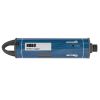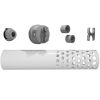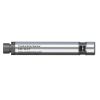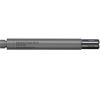HOBO CTD Sensors
Features
- 4-electrode conductivity sensor provides wide measurement range for monitoring freshwater or saltwater
- Durable ceramic water level sensor, located in the sensor tip for accurate measurement of shallow water levels
- Get water level directly with the MX802, no need for post-processing
- Free ground shipping
- Expedited repair and warranty service
- Lifetime technical support
- More
The CTD sensor is an interchangeable sensor that works with HOBO MX800 Series Water Loggers to measure conductivity, temperature, and water level. With this sensor attached to a HOBO MX800 Series Water Logger, the logger can also calculate specific conductance, salinity, and total dissolved solids (TDS).
The CTD sensor can be attached directly to the fully submersible MX801 model, or attached via cable to the direct read MX802 model, which doesn’t require having to pull the sensor out of the water to download data.
| Sensor | |
| Dimensions | 2.5 cm (1 inch) diameter, 15 cm (6 inches) length |
| Weight | Approximately xx g (xx oz) in air; approximately xx g (xx oz) in saltwater |
| Wetted Materials | Passivated 316 Stainless steel housing rated for use in saltwater, Viton and Buna-N O-rings, PET sensor connector |
| Conductivity sensor: PET, platinum plating on electrodes | |
| Note: Sensor should be mounted so that it is not in contact with other metals | |
| Environmental Rating | IP68; Waterproof to 100m |
| Conductivity Measurements | |
| Measurement Range | Electrical conductivity and specific conductance: 0 to 100,000 µS/cm |
| Salinity using PSS-78: 2 to 42 PSU | |
| Total Dissolved Solids (TDS): 0 to 100,000 mg/L | |
| Calibration Range | Electrical conductivity: 50 to 80,000 µS/cm |
| 5° to 35°C (41° to 95°F) | |
| Accuracy | Conductivity: +/-2% or 15 µS/cm whichever is greater |
| Salinity: +/-2% of reading or 0.1 PSU, whichever is greater | |
| Resolution | Conductivity:0.1 µS/cm from 0 to 1,000 µS/cm | 1 µS/cm from 1,000 to 10,000 µS/cm |10 µS/cm from 10,000 to 100,000 µS/cm |
| Salinity: 0.01 PSU | |
| TDS: 0.1 mg/L | |
| Response Time | 1 second to 90% at a stable temperature |
| Temperature Measurements | |
| Range | -20° to 50°C (-40° to 122°F), non-freezing water |
| Accuracy | ±0.15°C (±0.27°F) from 0° to 50°C (32° to 122°F) |
| Resolution | 0.01°C at 25°C (0.018°F at 77°F) |
| Response Time | 3 minutes to 90% in water (typical) |
| Drift | <0.1°C (0.18°F) per year |
| Absolute Pressure and Water Level Measurements W-CTD-04 | |
| Range | 0 to 145 kPa (0 to 21 psia); approximately 0 to 4 m (0 to 13 ft) of water depth at sea level, or 0 to 7 m (0 to 23 ft) of water at 3,000 m (10,000 ft) of altitude |
| Factory Calibrated Range | 69 to 145 kPa (10 to 21 psia), 0° to 40°C (32° to 104°F) |
| Burst Pressure | 310 kPa (45 psia) or 18 m (60 ft) depth |
| Water Level Accuracy* | Typical error: ±0.075% FS, 0.3 cm (0.01 ft) water |
| Maximum error: : ±0.15% FS, 0.6 cm (0.02 ft) water | |
| Raw Pressure Accuracy** | ±0.3% FS, 0.43 kPa (0.063 psi) maximum error |
| Resolution | <0.014 kPa (0.002 psi), 0.14 cm (0.005 ft) water |
| Pressure Response Time*** | <1 second to 90% at a stable temperature |
| Absolute Pressure and Water Level Measurements W-CTD-01 | |
| Range | 0 to 207 kPa (0 to 30 psia); approximately 0 to 9 m (0 to 30 ft) of water depth at sea level, or 0 to 12 m (0 to 40 ft) of water at 3,000 m (10,000 ft) of altitude |
| Factory Calibrated Range | 69 to 207 kPa (10 to 30 psia), 0° to 40°C (32° to 104°F) |
| Burst Pressure | 310 kPa (45 psia) or 18 m (60 ft) depth |
| Water Level Accuracy* | Typical error: ±0.05% FS, 0.5 cm (0.015 ft) water |
| Maximum error: ±0.1% FS, 1.0 cm (0.03 ft) water | |
| Raw Pressure Accuracy** | ±0.3% FS, 0.62 kPa (0.09 psi) maximum error |
| Resolution | <0.02 kPa (0.003 psi), 0.21 cm (0.007 ft) water |
| Pressure Response Time*** | <1 second to 90% at a stable temperature |
| Absolute Pressure and Water Level Measurements W-CTD-02 | |
| Range | 0 to 400 kPa (0 to 58 psia); approximately 0 to 30.6 m (0 to 100 ft) of water depth at sea level, or 0 to 33.6 m (0 to 111 ft) of water at 3,000 m (10,000 ft) of altitude |
| Factory Calibrated Range | 69 to 400 kPa (10 to 58 psia), 0° to 40°C (32° to 104°F) |
| Burst Pressure | 500 kPa (72.5 psia) or 40.8 m (134 ft) depth |
| Water Level Accuracy* | Typical error: ±0.05% FS, 1.5 cm (0.05 ft) water |
| Maximum error: ±0.1% FS, 3.0 cm (0.1 ft) water | |
| Raw Pressure Accuracy** | ±0.3% FS, 1.20 kPa (0.17 psi) maximum error |
| Resolution | ±0.3% FS, 1.20 kPa (0.17 psi) maximum error |
| Pressure Response Time*** | <1 second to 90% at a stable temperature |
| Absolute Pressure and Water Level Measurements W-CTD-03 | |
| Range | 0 to 850 kPa (0 to 123.3 psia); approximately 0 to 76.5 m (0 to 251 ft) of water depth at sea level, or 0 to 79.5 m (0 to 262 ft) of water at 3,000 m (10,000 ft) of altitude |
| Factory Calibrated Range | 69 to 850 kPa (10 to 123.3 psia), 0° to 40°C (32° to 104°F) |
| Burst Pressure | 1,200 kPa (174 psia) or 112 m (368 ft) depth |
| Water Level Accuracy* | Typical error: ±0.05% FS, 3.8 cm (0.125 ft) water |
| Maximum error: ±0.1% FS, 7.6 cm (0.25 ft) water | |
| Raw Pressure Accuracy** | ±0.3% FS, 2.55 kPa (0.37 psi) maximum error |
| Resolution | <0.085 kPa (0.012 psi), 0.87 cm (0.028 ft) water |
| Pressure Response Time*** | <1 second to 90% at a stable temperature |
| *Water Level Accuracy: With accurate reference water level measurement, known water density, and a stable temperature environment. System Water Level Accuracy equals the sum of the Barometric Water Level Accuracy plus the selected CTD sensor Water Level Accuracy. | |
| ** Raw Pressure Accuracy: Absolute pressure sensor accuracy includes all sensor drift, temperature, and hysteresis-induced errors. | |
| ***Changes in Temperature: Allow 20 minutes in water to achieve full temperature compensation of the pressure sensor. There can be up to 0.5% of additional error due to rapid temperature changes. | |
In The News
From Paddles to Phytoplankton: Studying Vermont’s Wildest Lakes
For six months of the year, Rachel Cray, a third-year PhD student at the Vermont Limnology Laboratory at the University of Vermont, lives between a microscope and her laptop, running data. For the other six months, she is hiking and canoeing four of Vermont’s lakes, collecting bi-weekly water samples. Cray studies algal phenology across four lakes in Vermont, US, that have low anthropogenic stress—or in other words, are very remote. Funded by the National Science Foundation Career Award to Dr. Mindy Morales, the lakes Cray researches part of the Vermont Sentinel Lakes Program, which studies 13 lakes in the area and, in turn, feeds into the Regional Monitoring Network, which operates in the Northeast and Midwest US.
Read MoreReimagining Water Filtration: How Monitoring and Science Enhance FloWater Filtration Systems
Over 50% of Americans think their tap water is unsafe , according to the Environmental Working Group (EWG). Other recent surveys have found that number to be as high as 70% of persons surveyed. Whether due to increased public awareness of water quality issues or confusion about how municipal water sources are regulated, there is a clear distrust of tap water in the United States. According to industry expert Rich Razgaitis, CEO and co-founder of the water purification company FloWater, this issue creates a damaging cycle. Razgaitis explained that the health and environmental problems associated with contaminated water aren’t the only issues. As people become increasingly aware that some tap water is unsafe, they resort to bottled water.
Read MoreMonitoring New Hampshire’s Aquatic Ecosystems: Continuous Data Collection in the Lamprey River Watershed
New Hampshire’s aquatic ecosystems provide a range of ecosystem services to the state and region. Resources and services like clean water, carbon storage, climate regulation, nutrient regulation, and opportunities for recreation all depend on New Hampshire’s aquatic ecosystems remaining healthy. Jody Potter, an analytical instrumentation scientist at the University of New Hampshire (UNH), is studying these aquatic ecosystems in hopes of developing an improved understanding of ecosystem services and their interactions with climate change, climate variability, and land use changes. [caption id="attachment_39799" align="alignnone" width="940"] Aquatic sensors in the Merrimack River in Bedford, NH, with I-293 in the background.
Read More
































